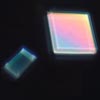Crystal growth
We study the evolution of the first stages of the crystallization of an electrochemically deposited calcium carbonate on Indium Tin Oxide (ITO) electrode. The electrodeposition is driven by applying a constant negative potential to a NaHCO3 and CaCl2 solution saturated with molecular oxygen. In this way, novel data about the kinetics of the crystal growth of CaCO3 were collected from the AFM images. The results show that at the solution supersaturation levels used, the crystal growth occurrs by a uniform surface nucleation mechanism. During the growth of the initial nuclei, the surface of the electrode is covered progressively by the growth of flat multilayers having triangular faces. The height of these structures ranges from one to five molecular layers of calcium carbonate. At the end of the crystallization process, the roughness of the electrode surface is reduced in average to two monolayers. Thus, our method provides a useful way to electrodeposit a nearly uniform layer of calcium carbonate on a variety of surfaces of potential applications.
We also study the growth of calcium carbonate using electrochemical methods. In particular, we investigate the morphology changes induced by Mg2+ and Alginic Acid from calcareous algae, in a Calcium Carbonate coating, electrodeposited on an Indium Tin oxide (ITO) transparent electrode. For this purpose we use differential interference contrast (DIC) microscopy, scanning electronic microscopy (SEM), and atomic force microscopy (AFM). The results showt, as it was expected, that the presence of Mg2+ induces the aragonite phase formation causing the sequential appearance of a variety of morphologies that we determined. The addition of alginic acid strongly inhibits the effect of Mg2+ on the crystallization of Calcium Carbonate acting in favor of the nucleation and growth of calcite phase. Calcite and aragonite phases were confirmed by X-Ray diffraction.

